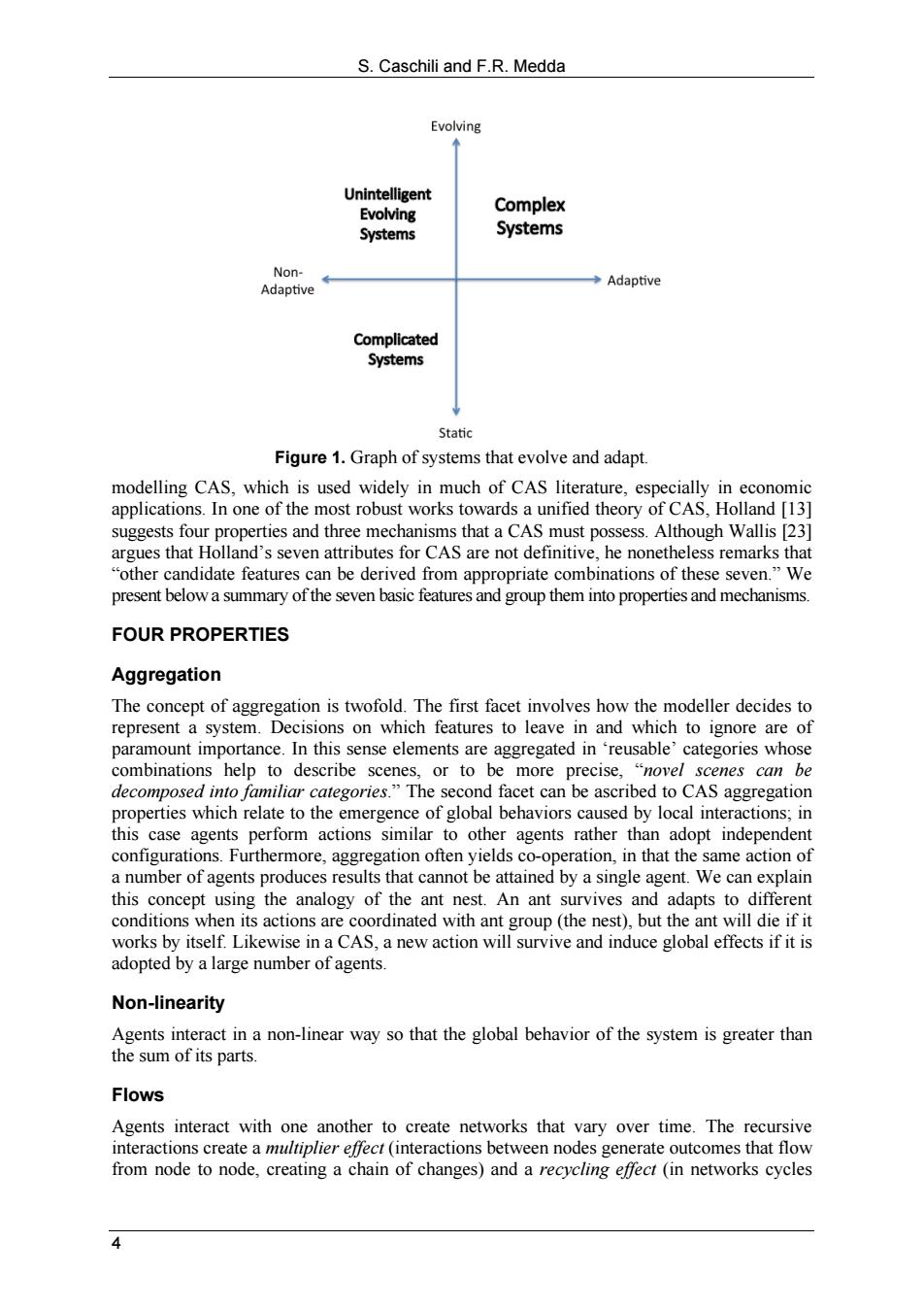正在加载图片...

S.Caschili and F.R.Medda Evolving Unintelligent Evolving Complex Systems Systems Non- →Adaptive Adaptive Complicated Systems Static Figure 1.Graph of systems that evolve and adapt. modelling CAS,which is used widely in much of CAS literature,especially in economic applications.In one of the most robust works towards a unified theory of CAS,Holland [13] suggests four properties and three mechanisms that a CAS must possess.Although Wallis [23] argues that Holland's seven attributes for CAS are not definitive,he nonetheless remarks that other candidate features can be derived from appropriate combinations of these seven."We present below a summary of the seven basic features and group them into properties and mechanisms. FOUR PROPERTIES Aggregation The concept of aggregation is twofold.The first facet involves how the modeller decides to represent a system.Decisions on which features to leave in and which to ignore are of paramount importance.In this sense elements are aggregated in 'reusable'categories whose combinations help to describe scenes,or to be more precise,"novel scenes can be decomposed into familiar categories."The second facet can be ascribed to CAS aggregation properties which relate to the emergence of global behaviors caused by local interactions;in this case agents perform actions similar to other agents rather than adopt independent configurations.Furthermore,aggregation often yields co-operation,in that the same action of a number of agents produces results that cannot be attained by a single agent.We can explain this concept using the analogy of the ant nest.An ant survives and adapts to different conditions when its actions are coordinated with ant group (the nest),but the ant will die if it works by itself.Likewise in a CAS,a new action will survive and induce global effects if it is adopted by a large number of agents. Non-linearity Agents interact in a non-linear way so that the global behavior of the system is greater than the sum of its parts. Flows Agents interact with one another to create networks that vary over time.The recursive interactions create a multiplier effect(interactions between nodes generate outcomes that flow from node to node,creating a chain of changes)and a recycling effect (in networks cyclesS. Caschili and F.R. Medda 4 Figure 1. Graph of systems that evolve and adapt. modelling CAS, which is used widely in much of CAS literature, especially in economic applications. In one of the most robust works towards a unified theory of CAS, Holland [13] suggests four properties and three mechanisms that a CAS must possess. Although Wallis [23] argues that Holland’s seven attributes for CAS are not definitive, he nonetheless remarks that “other candidate features can be derived from appropriate combinations of these seven.” We present below a summary of the seven basic features and group them into properties and mechanisms. FOUR PROPERTIES Aggregation The concept of aggregation is twofold. The first facet involves how the modeller decides to represent a system. Decisions on which features to leave in and which to ignore are of paramount importance. In this sense elements are aggregated in ‘reusable’ categories whose combinations help to describe scenes, or to be more precise, “novel scenes can be decomposed into familiar categories.” The second facet can be ascribed to CAS aggregation properties which relate to the emergence of global behaviors caused by local interactions; in this case agents perform actions similar to other agents rather than adopt independent configurations. Furthermore, aggregation often yields co-operation, in that the same action of a number of agents produces results that cannot be attained by a single agent. We can explain this concept using the analogy of the ant nest. An ant survives and adapts to different conditions when its actions are coordinated with ant group (the nest), but the ant will die if it works by itself. Likewise in a CAS, a new action will survive and induce global effects if it is adopted by a large number of agents. Non-linearity Agents interact in a non-linear way so that the global behavior of the system is greater than the sum of its parts. Flows Agents interact with one another to create networks that vary over time. The recursive interactions create a multiplier effect (interactions between nodes generate outcomes that flow from node to node, creating a chain of changes) and a recycling effect (in networks cycles